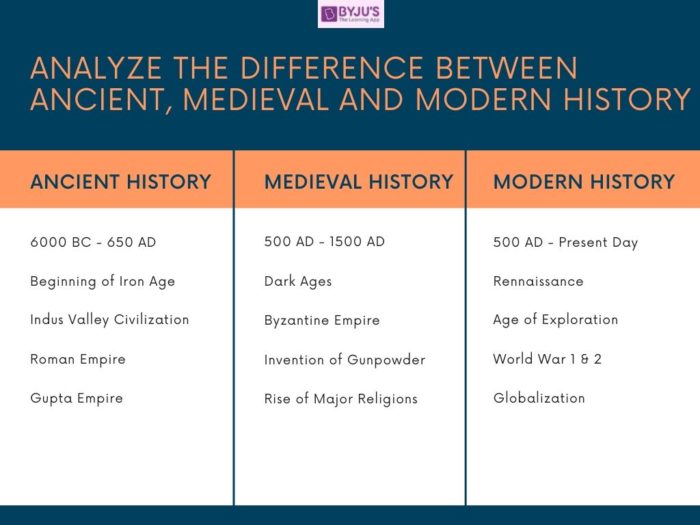The classification of history is based on assessing which period in time were the reliable records available.
History is a compulsory part of the UPSC Prelims (GS 1) and Mains stage (GS 1) and is also optional in the UPSC Mains Exam (2 papers)
Thus, time periods in history are divided into the following three to summarise significant eras in the history of the world:
- Ancient History
- Medieval History
- Modern History
Ancient history started when the earliest known human settlements were found (around 6000 BC). It ended with the fall of major empires such as the Roman Empire, the Han Empire of China and the Gupta Empire around 650 AD.
Medieval History, also known as post-classical history, is said to have begun around 500 AD, following the major cultural and religious upheaval that was common around this time.
The Modern Period covers the age of extra-continental expansions (like the exploration and colonisation of Asia and North America by the Europeans) to the present day.

This article will highlight the key differences between the three historical periods for the IAS Exam.
The difference between Ancient, Medieval and Modern History is given in the table below:
Differences between Ancient, Medieval and Modern History
| Ancient History | Medieval History |
Modern History |
| 6000 BC – 650 AD | 500 AD – 1500 AD | 500 AD-Present Day |
| This era of human history saw widespread use of bronze and iron tools, leading to the formation of composite human societies that eventually evolved into large empires. | There were many advances in science and technology such as the invention of gunpowder and increased trade between Asia and Europe. | The technological advances would usher in a new era of enlightenment with new systems of government overcoming the old systems. |
| The term “classical antiquity” is often confused with Ancient History when in fact it is used to describe the time period in Western History when Ancient Mediterranean Civilisations prospered. | In Europe, Medieval History is also referred to as the “Dark Ages” as many records were lost due to the chaos following the fall of the western half of the Roman Empire. | Contemporary history is either a subset of the late modern period, or it is one of the three major subsets of modern history, alongside the early modern period and the late modern period. The term contemporary history has been in use at least since the early 19th century. |
| It is estimated that the world population stood at around 72 million at around 1000 BC. By 500 AD it stood around by 209 Million. | The world population rose from 210 million in 500 AD to 461 million in 1500 AD. | The world population rose from 460 million in 1500 AD to 7 billion as of 2020 AD. |
| Significant events of this era include the rise of the Greek Kingdoms, the rise and fall of the Indus Valley Civilization and the establishment of international trade networks. | Although the Dark Ages have said to begin with the fall of the Roman Empire in the West in 476 AD, the invasion of Italy by its Eastern half (known as the Byzantine Empire) in 534 AD is said to be the true beginning of a period marked by anarchy and disorder. | The Renaissance of the 15th and 16th centuries heralded the beginning of the modern period as we know it today. This period was marked by a remarkable advancement in learning, medicine, technology and exploration. |
Aspirants can find study materials related to the History segment of the UPSC Exams through the links given below:
- NCERT Ancient Indian History Notes for UPSC
- NCERT Medieval Indian History Notes for UPSC
- NCERT Modern Indian History Notes for UPSC
- World History for UPSC Mains
- History Questions of UPSC Mains (2013 – 2019)
- How to Study and Prepare for History in the UPSC Exams
- UPSC History Syllabus
Difference Between Ancient, Medieval and Modern History UPSC Notes:- Download PDF Here
Candidates can find the general pattern of the UPSC Exams by visiting the UPSC Syllabus page. For more articles and exam-related preparation materials, refer to the links given in the table below:
Related Links

It really helps a lot. As I saw the brief discussion of Hindu newspaper for the first time. I was able to understand about every topic connected to national and international relations. I sincerely appreciate you for your kind efforts towards our beautiful country’s students.